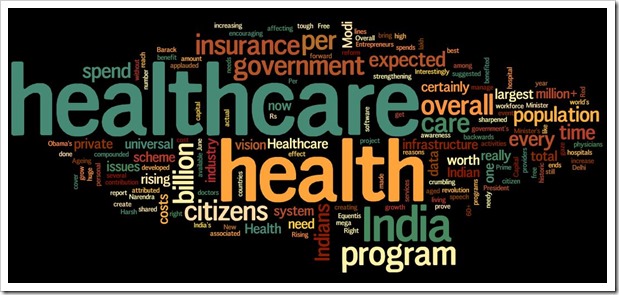Present
state of Healthcare in India !!!
- Healthcare in India is a story of
insufficient resources and poor outcomes.
- Investment is well below WHO
guidelines in both qualitative and quantitative terms.
- Bed density is low (less than 1.5 beds per 1000 persons as compared to
WHO guideline of 3.5), doctors
few (less than 1.8
per 1000 as compared to WHO guideline of 2.5), and out of pocket spend high (86% as compared to an average of around 40% for low
income countries).
- Rural India lags even further
behind, with around 30% of the rural population having to travel over 30km
for treatment.
Significant
inequality in access is worsened as the existing healthcare workforce is
inadequate and under-utilised. With low salaries, insufficient incentives, lack
of career growth, inadequate training and inconsistent policies, the majority
of the medical workforce chooses not to practice in the formal sector. India’s
regulatory system hardly keeps up with the very diverse set of medical practitioners.
Meanwhile,
infectious and chronic diseases continue to prevail. Health indicators continue
to lag, healthcare spending is growing slower than GDP growth, out of pocket
spending continues to be high, and infrastructure gaps remain substantial.
 |
Universal
Healthcare around the WORLD !!
- Universal healthcare offers the
one solution, by extending access to healthcare as widely as possible and
providing quality care through minimum standards.
- Soviet Union implemented it in
1937, with the UK following nearly a decade later.
- Most nations have funded it
through general taxation, supplementing it by specific levies and private
payments.
- Compulsory insurance utilising
common risk compensation pools and a choice of insurance funds, such as in
the US and Switzerland, have helped reduce inequality and increase
access.
- Lives have been saved, with
resultant growth.
 |
What can
India do in this regards ?
- India’s government needs to play a
stewardship role. By focusing on universal healthcare as a long term journey,
with consensus on political backing and hard choices along with secured
long term funding, universal coverage for good quality healthcare can be
achieved.
- By building an effective
regulatory framework and consistent policies across states and the Centre,
workforce shortages can be overcome, along with integrating healthcare
facilities across the village, town and district levels.
- Patient interest can be kept as a
primary focus by reforming such bodies as the National Rural Health
Mission and Rashtriya Swasthya Bima Yojana (RSBY).
Role of
Private sector !!
Private
sector can help improve India’s healthcare infrastructure. But without faster
accreditation, few private players will gain credibility, or raise standards,
resulting in low customer satisfaction, longer hospital stays and poor
governance. The National Accreditation Board for Hospitals and Healthcare
Providers needs to roll out incentives encouraging accreditation and make it a
mandatory process.
Finding of
a Kolkata Group led by AMARTYA SEN !!
- The Kolkata
Group led by Amartya Sen, in its 2011 Public Declaration, pointed to the
many limitations of the private sector in health. “Influential
policymakers in India seem to be attracted by the idea that private health
care, properly subsidised, or private health insurance, subsidised by the
State, can meet the challenge. However, there are good analytical reasons
why this is unlikely to happen because of informational asymmetry (the
patient can be easily fooled by profit-seeking providers on what exactly
is being provided) and because of the ‘public goods' character of health
care thanks to the interdependences involved. There are also major
decisional problems that lead to the gross neglect of the interests of
women and children in family decisions.” It is also well known that
insurance schemes (whether funded by the Central and State governments) at
best provide limited health care and at worst divert a large part of the
health budget to expensive hospitalised tertiary and secondary care, to
the great neglect of primary care.
- Clearly, there
is no alternative to a progressive strengthening of the public facilities
and thereby reduce people's dependence on private providers. However, the
public system may need to “contract-in” the services of willing private
providers, to fill gaps in its capacity to deliver all the services
assured under UHC. Such “contracted-in” private providers will have to
deliver cashless services and would be compensated on the basis of
pre-determined cost per package of health services rather than “fee for
service” for each visit or procedure. In such an arrangement, the private
sector acts as an extension of the public sector where needed and will not
compete for the same set of services for the same people.
PPP
projects !!
- Public-private partnerships or
build-operate-transfer or operations and maintenance contracting schemes
can utilise private capital for provisioning healthcare services.
- With our growing population, the
need for treatment of non-communicable and lifestyle
diseases will increase, particularly in Tier 2 and 3
cities.
- Affordable healthcare programmes
(rolled out as public-private partnerships) will offer significant margins
(in volume) for private players, while helping to address talent
resourcing and under-utilisation issues.
- Initiatives like Ayush Graham Bahawali Project, in Nainital, running on a build-operate-transfer mode, provide
alternative medicine and low cost affordable healthcare, partly based on
land grants by the government.
Insurance
Coverage !!
- Insurance coverage
is also abysmal in India, with just
around 25% of the population covered.
- To achieve universal
access, a coverage ratio of around 75% needs to be targeted, with the
remainder offered access through government payments via RSBY.
- Access with low out
of pocket spending can be achieved through an expansion of healthcare
insurance, with the government playing a payor or guarantor role instead
of providing services.
Social
insurance schemes really need to be rolled out at scale, with the government
deploying a greater share of healthcare funds for RSBY. Pilot programmes
launched at a state level can help us determine the best model for the Indian
market.
Community
health insurance schemes like those launched by the Karuna Trust in Karnataka help improve access and utilisation of health services by the
rural poor. Those left behind in India’s growth should be offered a helping
hand.
Drug
Pricing !!
- Universal healthcare requires
cheaper drugs. Capping drug prices has become controversial. But pharma
firms are coming under pressure to lower drug prices across the world.
- Our
inconsistent drug pricing regime offers high volatility. The last drug pricing
control order fixed the prices of 348 drugs based on the simple average
market price of the product, with no relationship to manufacturing cost. The latest order adds
a further 100 drugs to this scheme, with little consultation. Such ad hoc
policies create uncertainty, reducing incentives to foster innovation or
bring new drugs to the Indian market.
While
drug providers could crib about purported losses, the domestic pharma market is
75% of the volume exported. Drug providers should take a price cut and benefit
from India’s healthcare expansion. Public interest can also be private
interest, in greater volumes.
********************************************************************************************
- Regulatory
systems need strengthening — from hospital accreditation to health
professional education and from drug licensing to mandatory adoption of
standard management guidelines for diagnosis and treatment of different
disease conditions at each level of health care.
- A national inter-operable Health Information Network is needed to improve governance, accountability,
portability, storage of health records and management.
- Community
participation must be supported to actively engage people in the design,
delivery, monitoring and evaluation of health programmes.
- And
finally, larger investments should be made in health promoting programmes
in other sectors such as water, sanitation, nutrition, environment, urban
design and livelihood generation.
*******************************************************************************************
High
Level Expert Group (HLEG) by Planning Commission on UHC !!
- The
High Level Expert Group (HLEG) established by the Planning Commission has
submitted a comprehensive framework for providing UHC in India.
- A health entitlement card should assure every
citizen access to a national health package of essential primary,
secondary and tertiary care, both inpatient and outpatient.
- The
HLEG is very clear that services included under UHC must be tax funded and
cashless at delivery.
- User
fees are to be abolished because they are inefficient, inadequate and
iniquitous.
- Contributory
social insurance is not appropriate for countries like India where
a large segment of the workforce — close to 93 per cent — is in the
unorganised sector and vast numbers are below or near the poverty line.
******************************************************************************************
Moral of the STORY !!!
It is
time to recognise that everyone, not just the poor, needs to be protected
against rising health costs that can impoverish any family. We are on the
threshold of a historic transition to guarantee health security for all
Indians. UHC will greatly reduce out-of-pocket expenditures and provide much needed relief to people. Apart from
improving people's health, adopting UHC is likely to generate millions of new
jobs, enhance productivity, and promote equity. Statesmanship must assert
itself to create a national framework of UHC that is capable of State-specific
adaptations. It is time to give the people of India the efficient, affordable
and equitable health system they desire, deserve and demand.
********************************************************************************
Miscellaneous fact !!
- India's
public spending on health — just around 1.2 per cent of GDP — is among the
lowest in the world.
